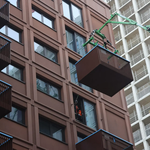lenaitch
Senior Member
Perhaps it's me folks, but I'm having a hard time getting my head around the concept of HFR on the old O&Q (Peterborough/Havelock) ROW. Assuming there is ROW capacity, to me it makes more sense to add trackage to the CN lakeshore ROW rather than spending money on a route that is a distance from the population centres along the lake and through an area of very limited potential revenue traffic. I sometimes wonder if some people (not here) think it will be as simple as clearing away the underbrush and laying down new rails. Some of ROW alignment and close proximity to residential areas will likely require lower speeds that I'm not sure could be made up in other areas to result in a decent average speed. Will initial enthusiasm from 'northern route' municipalities fade away when they learn that they won't be a station stop and the trains will simply be seen as a disruptive annoyance to taxpaying residents?
On article I read suggested expanding the CP Belleville/Winchester sub route because it is underused. Even if that is true (which I'm not convinced it is), I'm not sure that improves things.
Once in Toronto, what route will it take and how much will that cost? If it stays on CP, there is a yard in the way. If it wants to head to Union, what about the viaduct and exposure to flooding on the Don Branch? In another study regarding GO to Peterborough, one of the options was a new ROW connecting to the Stouffville line. How do you interweave 15-minute service with stops and hourly service without (assuming an inter-city service would not do commuter stops). As mentioned previously, perhaps there are high-tech train control systems to make it work, if they can be proven and approved in Canada.
Regardless of which route, between high-frequency inter-city service and high-frequency commuter service, at what point does Union reach its 'slot limit'.
Maybe it's just me and my non-visionary brain thinking out loud. I'm not as engaged in the issues as many here.
On article I read suggested expanding the CP Belleville/Winchester sub route because it is underused. Even if that is true (which I'm not convinced it is), I'm not sure that improves things.
Once in Toronto, what route will it take and how much will that cost? If it stays on CP, there is a yard in the way. If it wants to head to Union, what about the viaduct and exposure to flooding on the Don Branch? In another study regarding GO to Peterborough, one of the options was a new ROW connecting to the Stouffville line. How do you interweave 15-minute service with stops and hourly service without (assuming an inter-city service would not do commuter stops). As mentioned previously, perhaps there are high-tech train control systems to make it work, if they can be proven and approved in Canada.
Regardless of which route, between high-frequency inter-city service and high-frequency commuter service, at what point does Union reach its 'slot limit'.
Maybe it's just me and my non-visionary brain thinking out loud. I'm not as engaged in the issues as many here.




